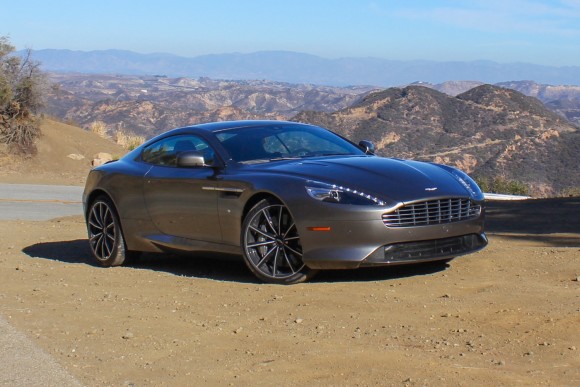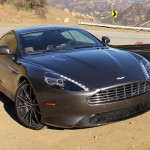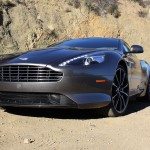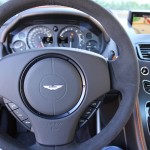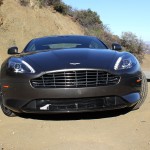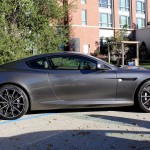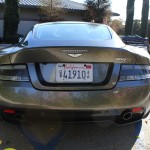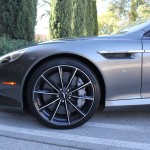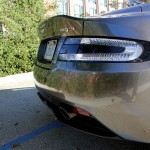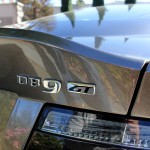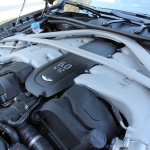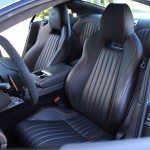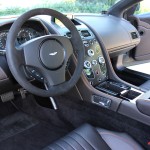The iconic grand tourer’s farewell performance is as thrilling and relevant as ever.
Young or old, there’s a good chance the Aston Martin DB9 has had some influence on an automotive aficionado in your life. Introduced in 2003, the silky-smooth sports car didn’t just improve upon the DB7’s handsome looks, it brought the grand tourer into the major leagues of cool.
Bolder, and yet more refined than the DB7, the DB9 has weathered dramatic changes in vehicular design over the past 12 years, without an ounce of grace lost. Paired with a V12 engine note that perks the ears of angels in heaven, it’s nearly impossible to be a hater, even from down below.
Alas, even timeless design can only endure so long within the automotive realm, and come next year, Aston Martin will show the world its new face, previewed by the DB10 concept. But that day has not come yet, and Aston Martin is giving the DB9 a fitting send-off via its most powerful version yet – the 2016 DB9 GT.
Look before you touch
While some sports cars demand you clamber into the drivers seat before you begin fully enjoying them, Aston Martin’s DB9 GT initiates your hot-and-bothered fantasy the moment your eyes glimpse its curves.
Aesthetically, there are only subtle distinctions between the standard DB9 and the GT, but a careful observer will tell them apart. From most obvious to least, Aston Martin has applied “GT” badges, stitching, and engraving inside and out, 20-inch alloy wheels, a black painted front splitter and rear diffuser, and tweaked headlight and taillight designs. For a more personalized (read: expensive) touch, the British marque offers carbon fiber taillight inserts, side strakes, front splitter and rear diffuser; graphite, diamond-turned ten-spoke alloy wheels and alternative brake caliper colors.
Related: 2015 Aston Martin Rapide S Review
GT enhancements or not, Aston Martin’s DB9 is still one of the most recognizable shapes on the road – mimicked by many but never quite matched in beauty. Its pursed-lips, crouched stance, endless hood, squared-shoulders, and velvety-smooth lines make the heart race long before your fingers clasp the door handle.
Saddle up for something exquisite
Hand-crafted is not something the world sees much of anymore, especially when it comes to vehicle manufacturing. Aston Martin, among a handful of other luxury automakers, holds onto the tradition, which also applies to its infamous naturally-aspirated V12 engines. At approximately 200 hours to assemble each model, though this practice occasionally leads to small fit-and-finish errors, it means a distinct connection between designer, engineer, and owner.
Once settled within the Aston Martin DB9 GT’s cabin, it’s infinitely clear that not only has a small team of individuals toiled meticulously over each stitch of the unique fluted leather, there’s palpable pride in the results. The 2+2 grand tourer feels as if it’s been tailored around each occupant, akin to a fine suit, with supple, snug sport seats and sultry touch points everywhere the eyes and hands might fall. Iridium trim and an Alcantara-wrapped steering wheel help distinguish the GT from the standard DB9. Aston Martin also offers a select few interior options, including Ice Mocha and Copper Cuprum finishes, Duotone leather seats, door inserts and head linings, and a One-77-inspired steering wheel design.
Continuing the luxury enhancements, Aston Martin has addressed its maligned infotainment system with the introduction of its AMi II touch-sensitive module on the 2016 DB9 GT. In fact, the whole center-stack is new, with a more intuitive layout of button-clusters and system controls. First shown on the range-topping 2016 Vanquish, the revised interface improves responsiveness to inputs and the menu structure to access important features more easily. Also new is text message integration, vehicle status information, and personalized background features. Rounding out its abilities, the system offers AM, FM, DAB and SDAR reception, USB ports, and Bluetooth streaming.
While there’s certainly nothing innovative about the latest iteration of in-car connectivity, the system is distinctly less frustrating to use than earlier versions and feels more premium. But let’s be honest, Aston Martin could wedge a slate stone within its dashboard and put a piece of chalk in the center console without insulting a soul. The moment you slide the weighted glass key into the ignition all you care about is finding an open stretch of tarmac.
Sound, fury, and a painfully-wide grin
Joy comes express delivery from a bloke in Warwick, England. Of course I’m referring to the hand-built 6.0-liter naturally-aspirated V12 front-mid mounted within the DB9 GT’s bonnet. Compared to the standard DB9, the GT variant adds 30 horsepower for a total of 540 while torque remains at 457 pound-feet. This translates to a 0 to 60 mph sprint of 4.5 seconds to the normal DB9’s 4.6-second run, and a top speed of 183 mph.
At a starting price of $215,040, the Aston Martin DB9 GT isn’t the quickest or most powerful vehicle for the money – McLaren’s 570S would trounce the poor Brit between stoplights or on a road course, for thousands less – but the smoothness with which thrust is delivered and the vinyl-quality sound of its engine validate the cost of admission. This is the original grand tourer, after all.
The curtains that contain the world’s most thrilling opera open and close with the pitch of your right foot. A dab of pressure from your extremity unleashes a sonorous wail of heritage-rich power. My recommendation: set up shop at about 3,000 rpms and silence your passengers with a religious experience. Sure, maximum torque is available at 5,500 rpms, but you’ll be so enamored with the engine note that you’re permitted to lose consciousness before the revs climb that high.
Should you find the road becoming more of a blur as the speeds increase, you can place confidence in the DB9 GT’s carbon ceramic disc brakes at all four corners. Stopping power is phenomenal and fade, non-existent. Beyond some tremendous motion-resistors, the DB9 GT features a double-wishbone independent suspension setup, front and rear, plus a three-stage adaptive damping system. With crisp steering response and a controlled, yet smooth ride, the DB9 GT affords a rich driving experience that errs on the side of comfort.
Perhaps the only knock on the DB9 GT’s driving dynamics pertains to its six-speed Steptronic automatic transmission. It’s not actually that there’s anything wrong with the GT’s gearbox, it’s simply that the updated ZF eight-speed unit (employed by the Rapide S) hits such a high mark within Aston Martin’s own stable. Shifts are fluid and relatively quick in the GT, but there’s a whisper of hesitation that the ZF gearbox banishes completely. Of course it’s unrealistic to completely overhaul the transmission in a final model year vehicle, but I can’t wait for what will no doubt be a phenomenal setup in the succeeding DB11.
The DB9 legacy will remain pure
I don’t attempt to hide my enthusiasm for the DB9. It’s an automotive icon that’s left as significant of an impression as vehicles like the Porsche 911 and Lotus Elise. For the few who can afford its charms (prices start at $199,950 for the coupe), the premium grand tourer communicates in form and function far more than words ever could about its owner. The 2016 DB9 GT is the last and purest expression of this sports car’s splendor, and while the DB11 will exceed its predecessor in terms of performance (in part thanks to a new Mercedes-AMG sourced twin-turbocharged V8), it will have the monumental task of crafting its own legacy.
It’s a bit akin the latest James Bond film, “Spectre”: tomorrow’s technology and engineering may hold great promise, but sometimes the established ways are best.
Highs
- A voluptuous design
- Naturally-aspirated sound and fury
- Tailor-made interior comfort
- The driver’s choice among GT’s
Lows
- In need of a higher-resolution infotainment display
- Missing out on the ZF eight-speed’s performance gains

